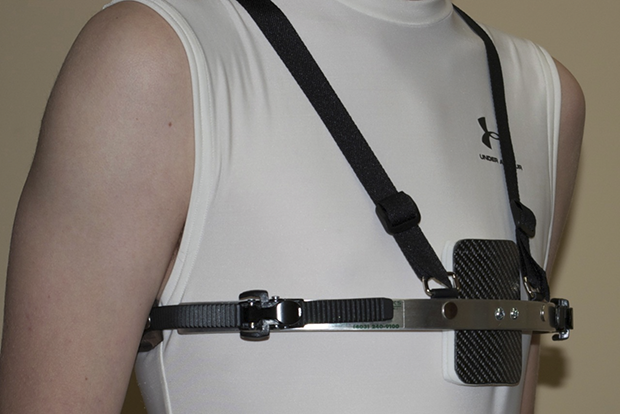The Calgary protocol for bracing of pectus carinatum: A preliminary report
| ABSTRACT |
| BACKGROUND |
The optimal treatment of pectus carinatum (PC) deformities is unclear. We propose a nonoperative approach using a lightweight, patient-controlled dynamic chest-bracing device.
| MATERIAL AND METHODS |
With ethical approval, 24 patients with PC were treated at the Alberta Children’s Hospital between January 1998 and April 2005. There were 6 (25%) females and 18 (75%) males, with a mean age of 12.9 years at the onset of treatment.
Treatment involved fitting of a lightweight, patient-controlled chest brace, worn for 23 hours per day (correction phase [CP]) until the convex deformity was corrected. Following correction of the deformity, bracing was reduced to 8 hours per day (maintenance phase) until axial skeletal maturation ceased. Monitoring was done by measurement of the external pectus carinatum protrusion as well as subjective patient and surgeon appraisal of appearance and exercise tolerance.
| RESULTS |
Nineteen (79.2%) patients have completed initial treatment (mean CP time, 4.3 +/- 2.1 months). There were 3 patients (12.5%) who were noncompliant, and 2 (8.3%) are still in the initial CP phase of therapy. Fourteen (58.3%) patients are presently in maintenance phase, nocturnally braced, and 2 (8.3%) have completed therapy.
In patients completing initial treatment, the protrusion pectus carinatum protrusion (pre 22 +/- 6 vs post 6.0 +/- 6.2) and subjective appearance (change + 1.8+/-0.4) showed a significant improvement (P < .001 for both) with no change in exercise tolerance.
| CONCLUSION |
Compressive bracing results in a significant subjective and objective improvement in PC appearance in skeletally immature patients.
However, patient compliance and diligent follow up appear to be paramount for the success of this method of treatment. Further studies are required to show the durability of this method of treatment.
| References |
The Calgary protocol for bracing of pectus carinatum: a preliminary report, Kravarusic D, Dicken BJ, Dewar R, Harder J, Poncet P, Schneider M, Sigalet DL. J Pediatr Surg. 2006 May;41(5):923-6. doi: 10.1016/j.jpedsurg.2006.01.058.

